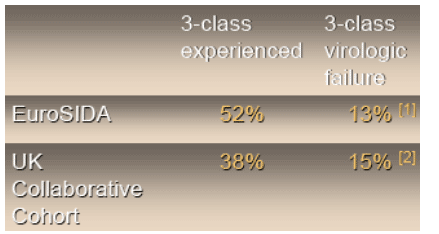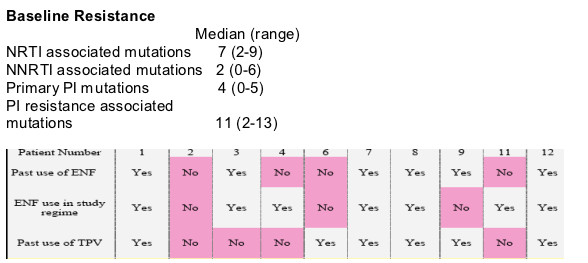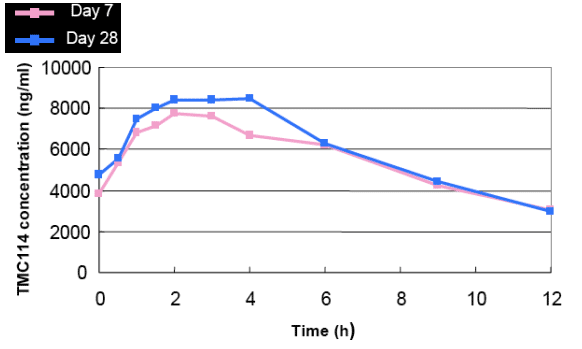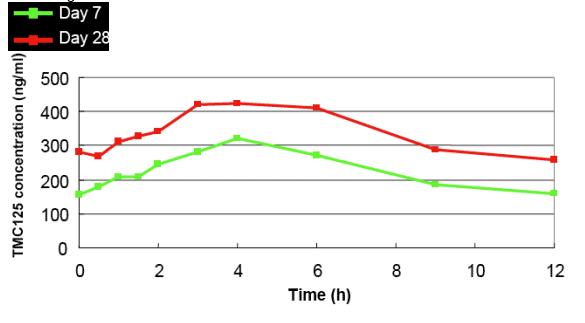| |
PK of TMC114 + TMC125
|
| |
| |
Reported by Jules Levin
"Pharmacokinetics (PK) and antiretroviral (ARV) response to TMC114/ritonavir ands TMC125 combination in patients with high-level resistance"
Presented at the BHIVA (British HIV Association) Conference, March 2006
Akil Jackson1, Marta Boffito1, Carl Fletcher1, Anton Pozniak1, Mark Nelson1, Graeme Moyle1, Izabela Tolowinska1, Richard Hoetelsmans2, Diego Miralles2, Brian Gazzard1 1St Stephen's Centre, C&W Hospital, London
2Tibotec BVBA, Mechelen, Belgium
Background
Resistance and cross-resistance to ARV lead to treatment failure and exhaustion of therapeutic options.
There is Increased prevalence of multiclass-resistant HIV
Optimal virologic efficacy; >/=2 active agents:
Requires novel agents with retained activity against resistant strains.
And tolerable adverse effect profile influences ongoing adherence

1 Mocroft et al. JID 2004;190:1947-1956
2 HIV Drug Resistance and UK CHIC. AIDS 2005; 19: 487-497
Candidates: TMC125
- Novel non-nucleoside (NNRTI) in current development
- High genetic barrier to resistance
- Phase II trials show significant, sustained activity in triple class experienced patients
- First NNRTI with activity in patients with prior NNRTI failure
- New formulation of 100 mg tablets - improved bioavailability
- 200 mg BID; comparable to exposure with 800mg BID of old formulation
TMC114
- Non-peptidic protease inhibitor (PI)
- With ritonavir boosting, rapid and robust VL reduction in both naive and
experienced patients
- Well tolerated
- Long-term efficacy in PI-experienced patients; filed for regulatory approval
Rationale
The drug interaction between TMC114/RTV and TMC125 has not been characterised in patients
Objectives
Determine PK, safety and tolerability of the co-administration of
TMC114 /ritonavir 600/100 mg BID and TMC125 200 mg BID
In multiple class experienced patients with limited therapeutic options
Methods
Screening
- Genotypic resistance (Virco BVBA), clinical laboratory tests (include CD4 and viral load)
Day 1, commenced:
- TMC125
- TMC114/r
- >/= 2 NRTI
- +/- ENF
Day 7 and 28
- 12 hour PK assessment after witnessed dose and standardised meal
Week 2, 6, 8, 12 and 16
- Clinical laboratory tests (include CD4 and viral load)
RESULTS
Patient demographics/characteristics
Sex: 8 male, 2 female
Age (years): median (range)- 43 (38-56)
Race: black 3, Caucasian 7
Log10 viral load (copies/ml): 4.6 (3.9-5.5)
CD4 count (x10-6th cells/L): 75 (3-490)

6 patients previously used tipranavir.
6 patients previously used Fuzeon. 7 patients using Fuzeon on study regime. 2 patients were naive to Fuzeon & used Fuzeon I study regime.
Pharmacokinetics: TMC114 plasma concentrations
(median values are shown)
Exposure to TMC114 similar to previously measured values in historical
controls - in the absence of TMC125.

Pharmacokinetics: TMC125 plasma concentrations
Median values are shown
Comparison to historical controls: modestly reduced (30%) exposure to TMC125.
TMC125 PK (Day 28) similar to PK measured when co-administering TMC125 with a boosted PI: median TMC125 AUC12h 3966 vs 3556 ng.h/ml and C0h 283 vs 196 ng/ml.

At week 16, median _ CD4 = 121; (range minus 35 to 220)
At week 16, median _ VL = 2.70 log10; (range 2.3 - 3.9)
Results: Safety
No serious adverse events or changes in lab safety were reported.
Possibly drug related adverse events were:
- mild diarrhoea (n = 1)
- headache (n = 1)
- grade 1 skin rash (n = 1)
- All resolved with continued dosing.
Conclusions
- No clinically significant PK interaction was observed between TMC125 and TMC114/ritonavir
- Impressive short-term efficacy against 3-class resistant HIV
- Well tolerated
- Further studies of this combination are warranted
|
|
| |
| |
|
|
|